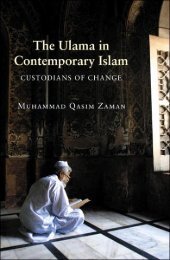The Qur'an in its historical context (pdf - Islam and Christian-Muslim ...
The Qur'an in its historical context (pdf - Islam and Christian-Muslim ...
The Qur'an in its historical context (pdf - Islam and Christian-Muslim ...
Create successful ePaper yourself
Turn your PDF publications into a flip-book with our unique Google optimized e-Paper software.
CHRISTIAN LORE AND THE ARABIC QUR’AN<br />
monk did not fall <strong>in</strong>to the bosom <strong>and</strong> bed of earthly love.” 20 ...<br />
Popular piety certa<strong>in</strong>ly <strong>in</strong>terpreted this dar<strong>in</strong>g imagery <strong>in</strong> a crass<br />
<strong>and</strong> literal sense, <strong>and</strong> under such circumstances one cannot blame<br />
a citizen of pagan Mecca for do<strong>in</strong>g the same th<strong>in</strong>g.<br />
(Andrae, Mohammed: <strong>The</strong> Man <strong>and</strong> His Faith, 88)<br />
In 1948 Dom Edmund Beck, OSB, the modern editor of the critical editions of<br />
most of the Syriac works of Ephraem the Syrian, wrote a response to what he<br />
took to be Tor Andrae’s claim about St Ephraem’s mean<strong>in</strong>g. 21 Beck took it that<br />
Andrae was propos<strong>in</strong>g that St Ephraem’s works suggested a heavenly reward for<br />
the celibate monk comparable to that provided by the houris of the Qur’an for the<br />
faithfully departed <strong>Muslim</strong>. So he went to some trouble to show that such could<br />
not have been St Ephraem’s mean<strong>in</strong>g. Beck called attention to the faulty text of<br />
the Editio Romana of Ephraem’s hymn that Andrae had used, <strong>and</strong> then he set<br />
about expla<strong>in</strong><strong>in</strong>g the imagery <strong>and</strong> symbolism of the passage <strong>in</strong> <strong>its</strong> <strong>context</strong>, by a<br />
somewhat complicated word-study of several key terms. In sum, Beck argued that<br />
St Ephraem’s imagery of the grape-v<strong>in</strong>e, <strong>its</strong> stocks <strong>and</strong> shoots, evoked a vision<br />
of Paradise <strong>and</strong> a l<strong>in</strong>e of th<strong>in</strong>k<strong>in</strong>g which he thought def<strong>in</strong>itively excluded any<br />
concept of the k<strong>in</strong>d of delights provided by the houris. While Beck’s exposition<br />
of St Ephraem’s own thought is conv<strong>in</strong>c<strong>in</strong>g, it seems that he did not <strong>in</strong> fact<br />
completely grasp Andrae’s po<strong>in</strong>t. Tor Andrae did not actually say that Ephraem<br />
envisioned anyth<strong>in</strong>g like houris <strong>in</strong> Paradise. Rather, he suggested that “popular<br />
piety,” not to mention “a citizen of pagan Mecca,” might have been <strong>in</strong>spired by<br />
such l<strong>in</strong>es as Ephraem wrote to conjure up the houris. It was Andrae’s major<br />
po<strong>in</strong>t, one should remember, that homiletic descriptions such as those by Ephraem,<br />
envision<strong>in</strong>g the bless<strong>in</strong>gs of Paradise <strong>in</strong> terms of a garden of delights, could<br />
reasonably be supposed somehow to lie beh<strong>in</strong>d the similar descriptions of Paradise<br />
<strong>in</strong> the Qur’an, especially if one would be prepared to concede that Ephraem’s<br />
descriptions could well have been reflected <strong>in</strong> the discourse of Arabic-speak<strong>in</strong>g<br />
<strong>Christian</strong>s who were <strong>in</strong> the audience of the Arabic Qur’an.<br />
In connection with a consideration of Tor Andrae’s suggestion about a Syriac<br />
background for the Qur’an’s depiction of Paradise, illustrated for him by reference<br />
to a passage <strong>in</strong> the works of St Ephraem the Syrian, it is <strong>in</strong>terest<strong>in</strong>g to note <strong>in</strong><br />
pass<strong>in</strong>g that Christoph Luxenberg, <strong>in</strong> what has become the most widely quoted<br />
part of his work, has on philological <strong>and</strong> lexical grounds re<strong>in</strong>terpreted the key<br />
phrase <strong>in</strong> Q al-Dukhan (44):54 <strong>and</strong> al-Tur (52):20, zawwajnahum bi-hur<strong>in</strong> ‘<strong>in</strong><strong>in</strong>,<br />
to mean not someth<strong>in</strong>g on the order of, “We shall wed them to maidens with large,<br />
dark eyes,” or “We pair them with beautiful-eyed maidens,” 22 but “We will make<br />
them comfortable under white, crystal(clear) (grape clusters),” 23 claim<strong>in</strong>g that so<br />
understood the expression is more consistent with the Qur’an’s own eschatological<br />
scenario. Whatever one might th<strong>in</strong>k of the verisimilitude of this <strong>in</strong>terpretation, it<br />
is clear that it is certa<strong>in</strong>ly closer to St Ephraem’s image of the grape clusters<br />
which the Syrian writer says will welcome the chaste <strong>in</strong>to their bosom than to the<br />
vision of the embraces of houris as conventionally imag<strong>in</strong>ed.<br />
113



